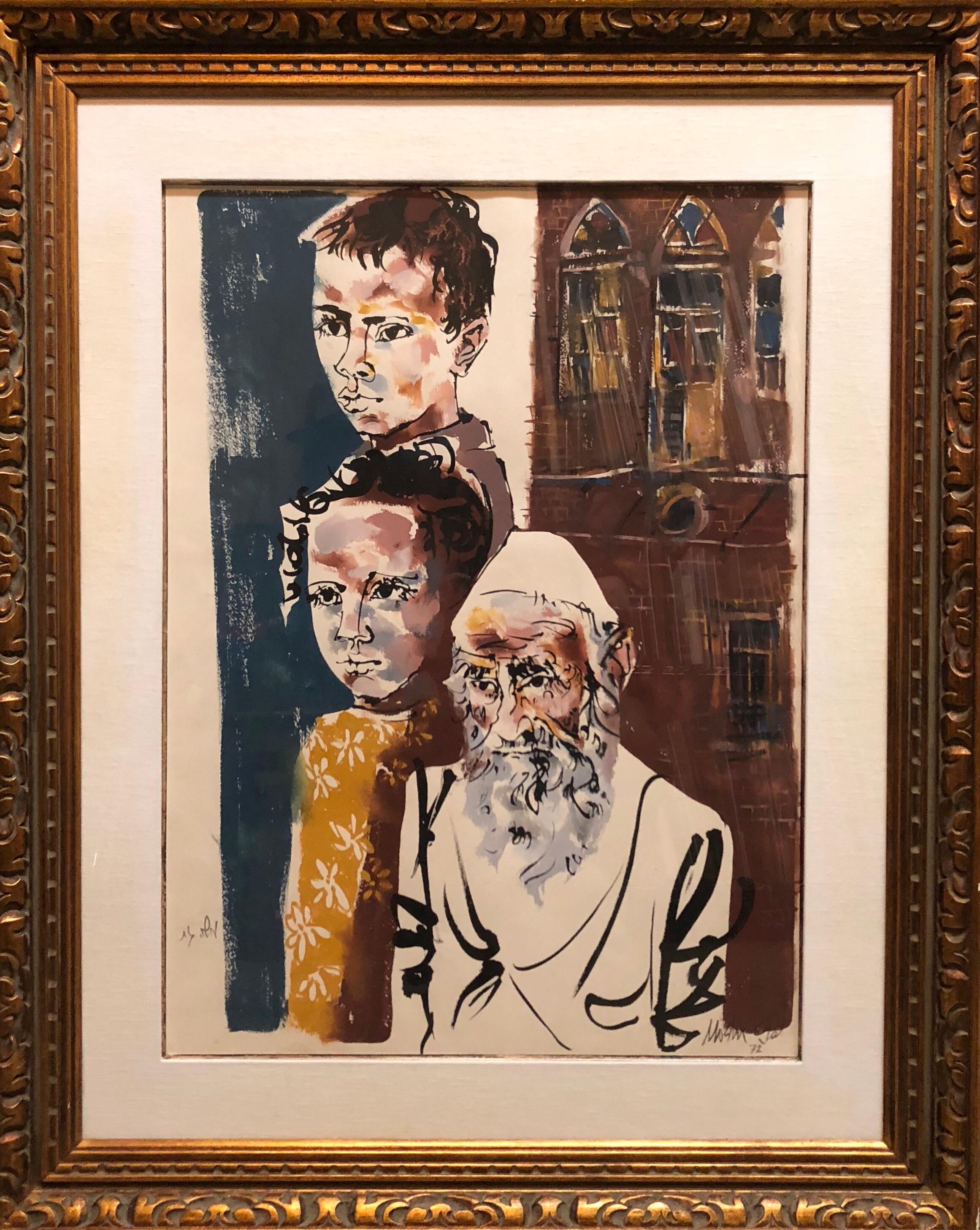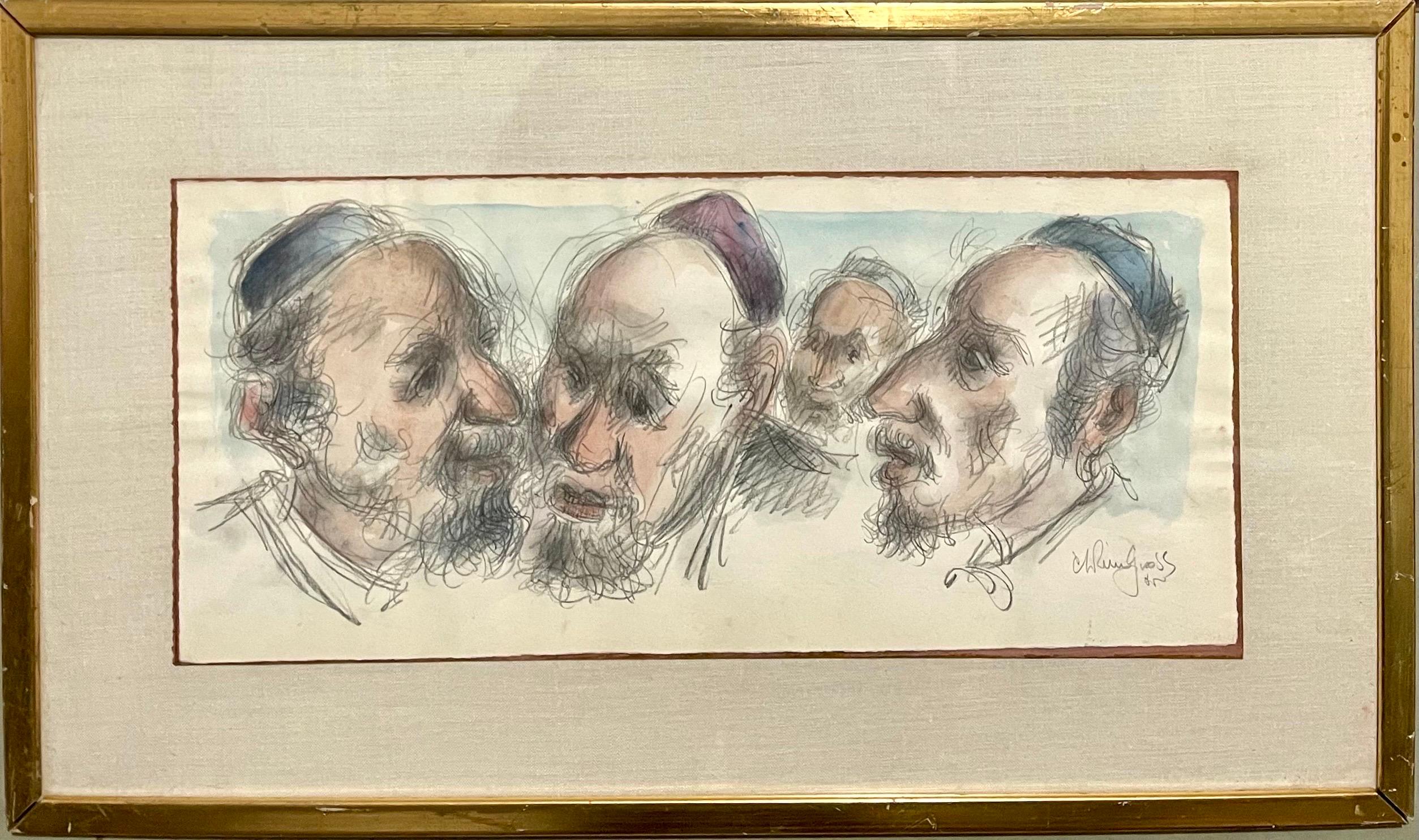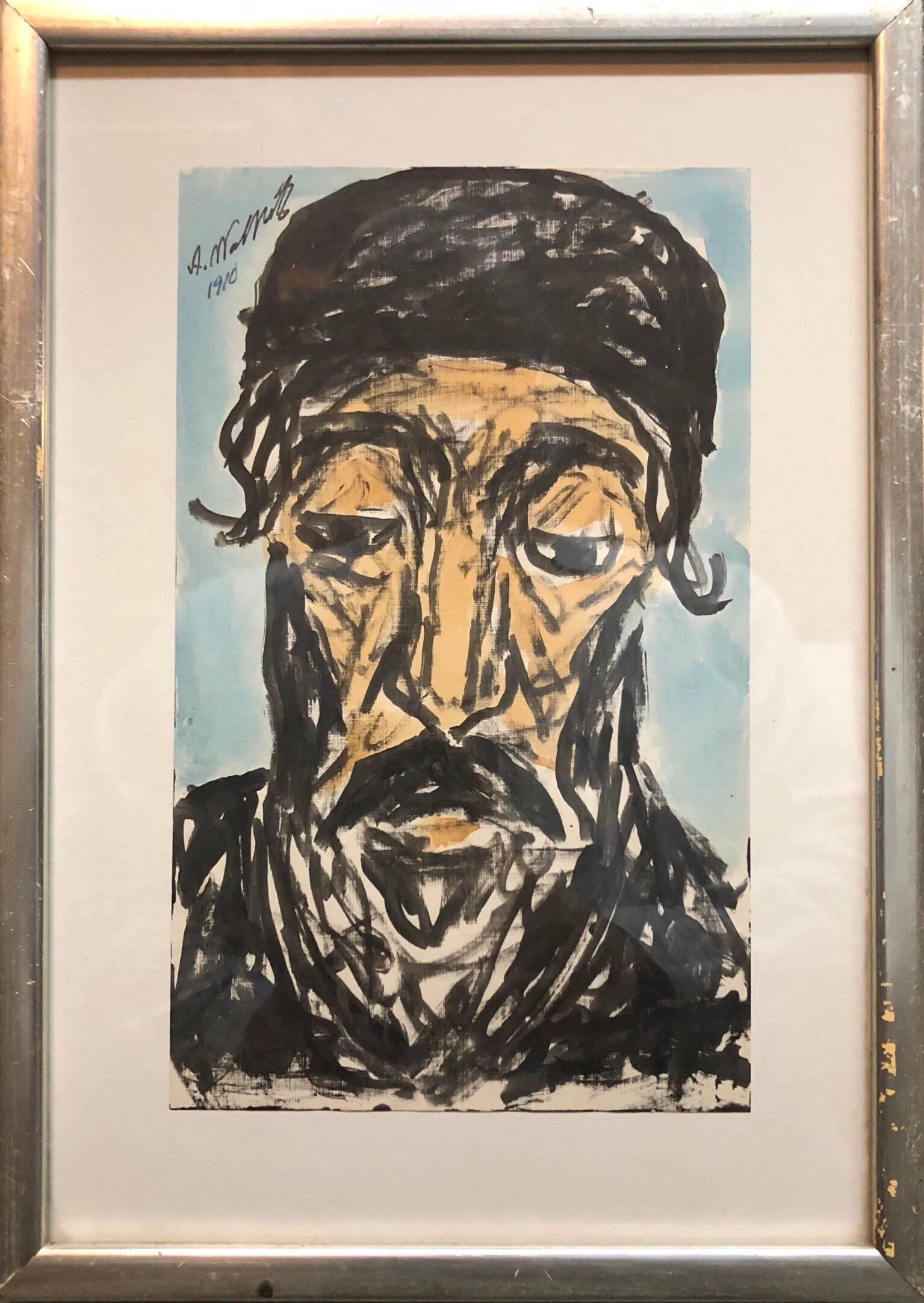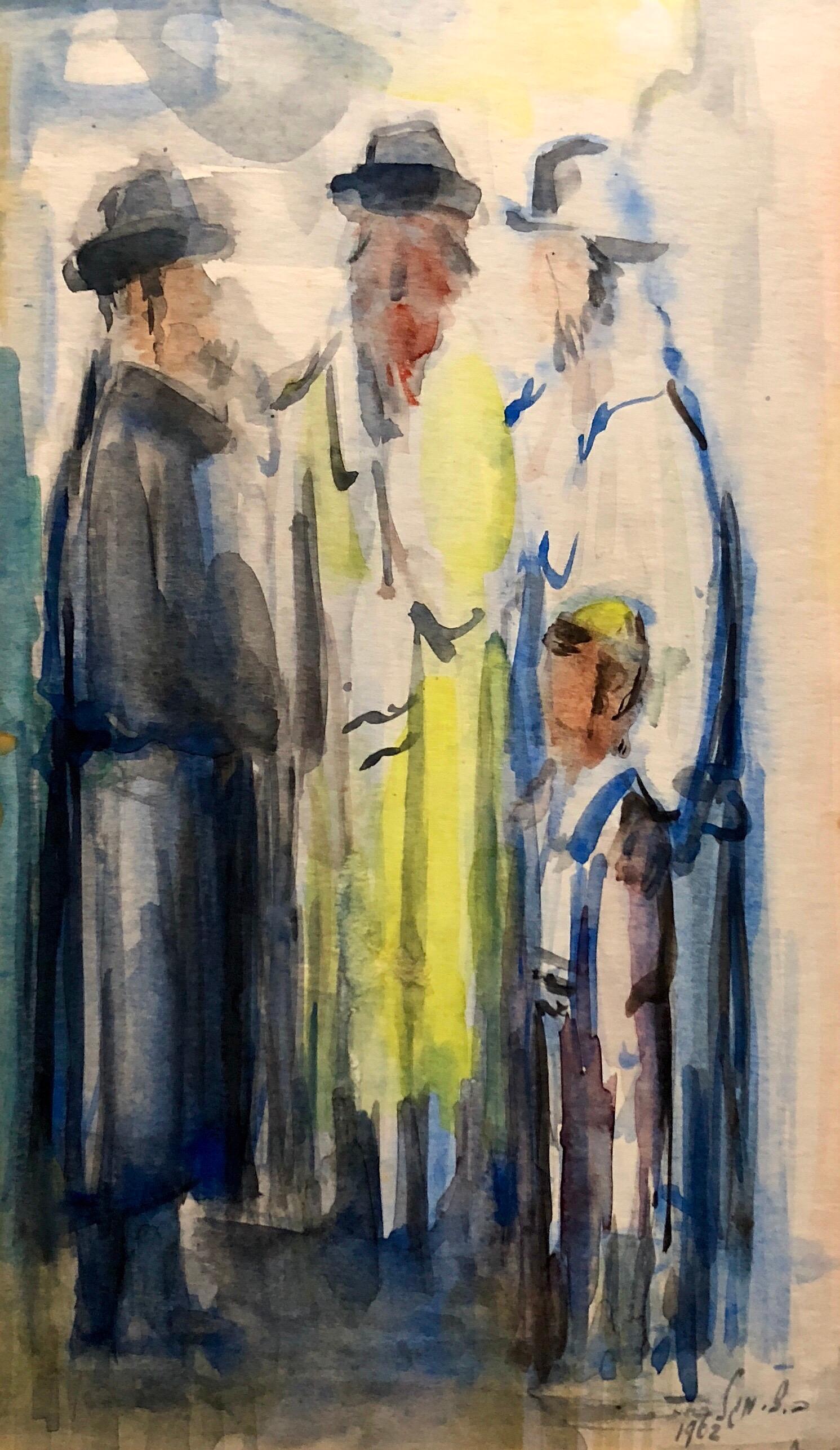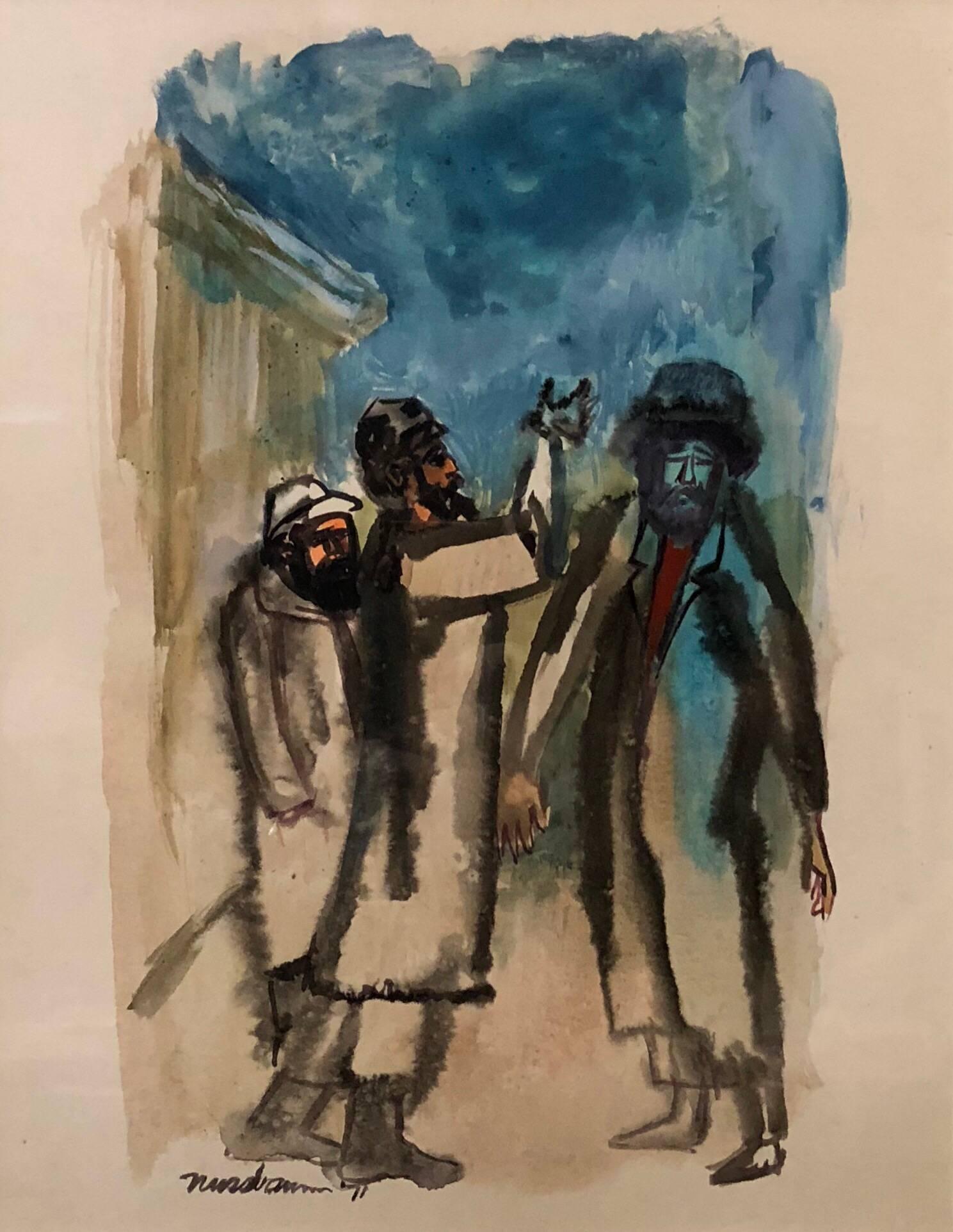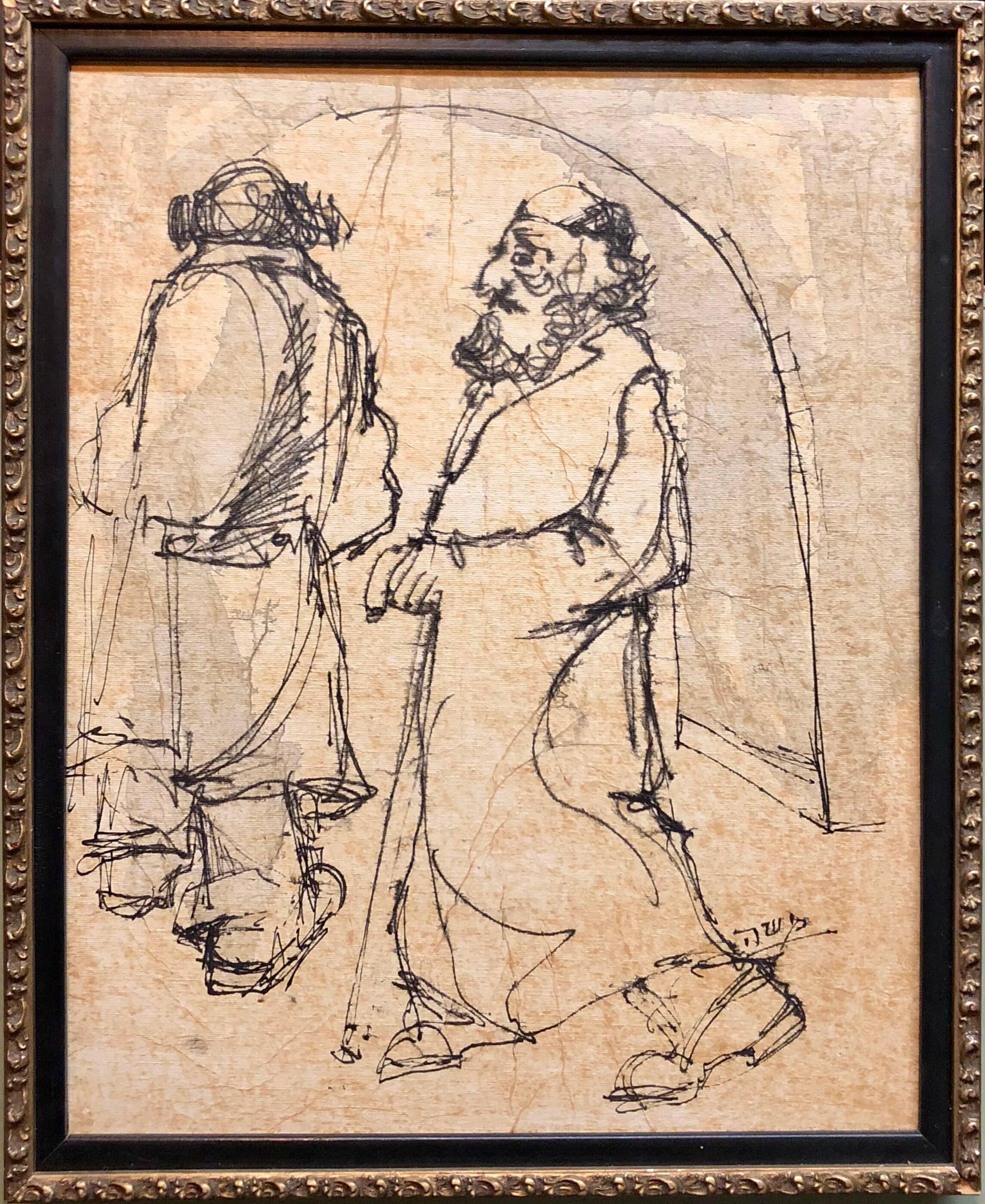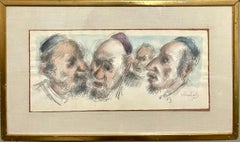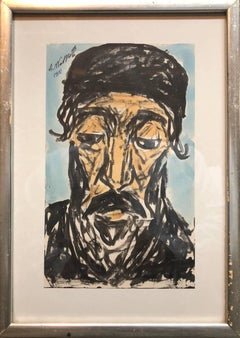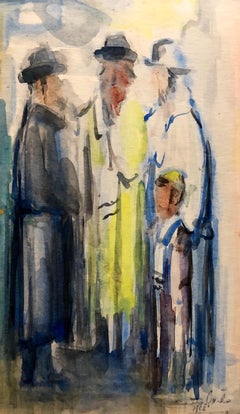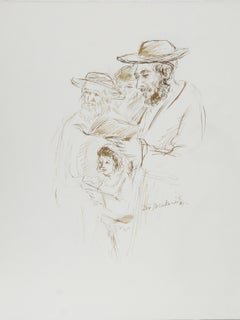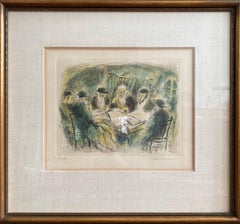Items Similar to Large Watercolor Painting Israeli Modernist Judaica Two Rabbis
Want more images or videos?
Request additional images or videos from the seller
1 of 7
Moshe GatLarge Watercolor Painting Israeli Modernist Judaica Two Rabbis1960
1960
$1,950
£1,467.33
€1,696.35
CA$2,753.46
A$2,985.55
CHF 1,584.40
MX$36,770.88
NOK 19,637.61
SEK 18,533.39
DKK 12,661.96
About the Item
A large watercolor painting.
Moshe Gat was born in Haifa in 1935.
in 1952 he began his studies at the Bezalel School, in Jerusalem.
In 1955 he returned to Haifa, where he taught drawing, and began to participate in important exhibitions being shown in Israel.
In 1957 he was awarded a grant by the America-Israel Cultural Fund, to further his studies abroad. He became a member of the Society of Painters and Sculptors in Israel, and held his first one-man exhibitions. The most important of these was in the Tel-Aviv Museum.
In 1958 he left Israel, and after an educational tour of the museums of Paris and Italy, he reached Mexico. Several months later, two of his works were accepted for the exhibition of artists of Mexico; this was part of the American Biannual, which brought together in the city the best of American art. Here, the Director of the National Museum of Modern Art saw the pictures and arranged a one-man show for Gat at the Museum of the Palace of Fine Arts in Mexico City.
In 1962 he held his first one man show at the ACA. Gallery in New York. He held exhibits too in New Orleans, Chicago, Detroit, Texas and elsewhere.
In 1962, after an absence of five years, the artist returned to Israel, and settled in Haifa. In the following year he held exhibitions at the Haifa Municipal Museum, the Bezalel Museum in Jerusalem, the Artist's House in Haifa, and Jerusalem, the Chermerinsky Gallery in Tel Aviv, and other places all over the country. These exhibitions mainly included works produced abroad, many of which were borrowed from private collections. In 1962 he began to teach drawing at the Bezalel School in Jerusalem.
Moshe Gat took part in the international exhibition at the Metropolitan Fine Art Gallery in Tokyo, where his woodcut "Three Old Women" won the prize for graphic art.
He was one of the twelve Israeli artists whose works were shown also at an exhibition held at Pushkin House in Moscow, early in 1965.
In 1965 he exhibited at the "Mer Kup" Gallery in Mexico City.
- Creator:Moshe Gat (1935)
- Creation Year:1960
- Dimensions:Height: 30 in (76.2 cm)Width: 37.5 in (95.25 cm)
- Medium:
- Movement & Style:
- Period:
- Condition:
- Gallery Location:Surfside, FL
- Reference Number:1stDibs: LU38212481832
About the Seller
4.9
Platinum Seller
Premium sellers with a 4.7+ rating and 24-hour response times
Established in 1995
1stDibs seller since 2014
1,807 sales on 1stDibs
Typical response time: 1 hour
- ShippingRetrieving quote...Shipping from: Surfside, FL
- Return Policy
Authenticity Guarantee
In the unlikely event there’s an issue with an item’s authenticity, contact us within 1 year for a full refund. DetailsMoney-Back Guarantee
If your item is not as described, is damaged in transit, or does not arrive, contact us within 7 days for a full refund. Details24-Hour Cancellation
You have a 24-hour grace period in which to reconsider your purchase, with no questions asked.Vetted Professional Sellers
Our world-class sellers must adhere to strict standards for service and quality, maintaining the integrity of our listings.Price-Match Guarantee
If you find that a seller listed the same item for a lower price elsewhere, we’ll match it.Trusted Global Delivery
Our best-in-class carrier network provides specialized shipping options worldwide, including custom delivery.More From This Seller
View AllLarge Watercolor Painting Israeli Modernist Judaica Rabbi with Children, Bezalel
By Moshe Gat
Located in Surfside, FL
A large watercolor painting.
Moshe Gat was born in Haifa in 1935.
in 1952 he began his studies at the Bezalel School, in Jerusalem.
In 1955 he returned to Haifa, where he taught dra...
Category
Mid-20th Century Expressionist Figurative Drawings and Watercolors
Materials
Paper, Watercolor
Chaim Gross Mid Century Mod Judaica Jewish Watercolor Painting Rabbis WPA Artist
By Chaim Gross
Located in Surfside, FL
Chaim Gross (American, 1904-1991)
Watercolor painting
Rabbinical Talmudic Discussion
Hand signed
17 x 29 framed, paper 10 x 22
Chaim Gross (March 17, 1904 – May 5, 1991) was an ...
Category
Mid-20th Century American Modern Figurative Drawings and Watercolors
Materials
Paper, Watercolor
Modernist Watercolor Painting, Portrait of a Man, Judaica Rabbi
By Abraham Walkowitz
Located in Surfside, FL
Abraham Walkowitz (March 28, 1878 - January 27, 1965) was an American painter grouped in with early American Modernists working in the Modernist style.
Walkowitz was born in Tyumen, Siberia to Jewish parents. He emigrated with his mother to the United States in his early childhood. He studied at the National Academy of Design in New York City and the Académie Julian in Paris under Jean-Paul Laurens. Walkowitz and his contemporaries later gravitated around photographer Alfred Stieglitz's 291 Gallery, originally titled the Little Galleries of the Photo-Secession, where the forerunners of modern art in America gathered and where many European artists were first exhibited in the United States. During the 291 years, Walkowitz worked closely with Stieglitz as well as Arthur Dove, Marsden Hartley, and John Marin (often referred to as "The Stieglitz Quartet").
Early Career and Training
Portrait of Abraham Walkowitz - 1907 - Max Weber - Brooklyn Museum
Walkowitz was drawn to art from childhood. In a 1958 oral interview with Abram Lerner...
Category
Early 20th Century Modern Figurative Drawings and Watercolors
Materials
Paper, Watercolor
Israeli Judaica Watercolor Gouache Bar Mitzvah Boy Rabbi Painting Russian Artist
By Ben Zion Magal
Located in Surfside, FL
Ben Zion Magal (1908 - 1999)
Ben Zion Magal was born in 1908 in Kishinev - Russia and there, years later, graduated from the Art Academy. He arrived to Erertz Israel together with hi...
Category
1960s Neo-Expressionist Figurative Paintings
Materials
Watercolor, Gouache
Modernist American Judaica Painting Rabbis in Conversation
By Ervin B. Nussbaum
Located in Surfside, FL
In this painting, Nussbaum portrays Rabbi in lively conversation outside the synagogue in a sketch-like manner without focusing on any specific details. The vibrant colors used in th...
Category
1970s Modern Figurative Paintings
Materials
Paper, Watercolor, Gouache
Modernist Israeli Judaica Mixed Media Painting Rabbis Walking In Jerusalem
By Moshe Katz
Located in Surfside, FL
Moshe Katz (Romanian Israeli), 1937- an Israeli citizen, studied art at the Bezalel Academy of Art in Jerusalem, as well as at the Chicago Academy of Fine Arts.
Although not an exponent of one dominating technique of painting, Moshe has been fascinated in recent months with the textures and expressions he is able to obtain with the pallette knife.
Picasso, Cezanne and Gaugin are his idols, and the power of Mexican art has a deep fascination for him. With elements of Folk Art combined with a sophisticated technique.
He enjoys working in clay but finds painting in oil his greatest outlet for the stories he has to tell through his pictures. In addition to an outstanding collection of books featuring the works of the great masters, his shelves are lined with texts about hypnosis. Studying about the art of hypnotizing provides him with a mental exercise far removed from his highly developed art of expressing himself on canvas. He has exhibited with the Painters and Sculptors Association in Israel, Haifa and the North along with artists: Yaacov Agam, Sela (Blaustein), Emanuel Pinhassi, Pasternak, Anna, Chaltiel, Joseph Schwartz, Nira Shemer, Aviva, Fadel, Mohamed Bishara, Sana, Menashe Kadishman, Menashe Shalhevet, Yitzchak Frumin, Moshe Rosen, Maureen
Moshe was born March 2, 1937 in Bucherest, Romania with his parents, he fled from the Nazis and after stops in many countries, reached Israel. His paintings have been displayed by Arts International...
Category
20th Century Modern Portrait Paintings
Materials
Canvas, Mixed Media, Acrylic
You May Also Like
Rabbis Studying the Thorah
By Jacob Steinhardt
Located in San Francisco, CA
Artist: Jakob Steinhardt (German/Israeli, 1887-1968)
Title: Rabbis Studying the Thorah
Year: Circa 1960
Medium: Color woodcut
Paper: Wove
Image size...
Category
Mid-20th Century Expressionist Figurative Prints
Materials
Woodcut
Price Upon Request
Hasidic Men Reading, Modern Ink on Paper by Ira Moskowitz
By Ira Moskowitz
Located in Long Island City, NY
Ira Moskowitz, Polish/American (1912 - 2001) - Hasidic Men Reading, Year: 1989, Medium: Ink on Paper, signed, Size: 13 in. x 10 in. (33.02 cm x 25.4 cm), Description: Gathered toge...
Category
1980s Modern Portrait Drawings and Watercolors
Materials
Ink
Jewish Family
By Boris Deutsch
Located in San Francisco, CA
This artwork "Jewish Family" 1968 is an acrylic and ink on wove paper by noted Lithuanian artist Boris Deutsch, 1892-1978. It is hand signed and dated at the lower left corner by the...
Category
Mid-20th Century Expressionist Figurative Drawings and Watercolors
Materials
Ink, Acrylic
Reading the Torah, Modern Hand Colored Etching by Ira Moskowitz
By Ira Moskowitz
Located in Long Island City, NY
Ira Moskowitz, Polish/American (1912 - 2001) - Reading the Torah, Medium: Hand Colored Etching, signed and numbered, Edition: 5/120, Size: 11 x 13.5 in. (27.94 x 34.29 cm), Frame S...
Category
1960s Modern Figurative Prints
Materials
Etching
Large Scale Oil On Canvas, Group Of Rabbis
Located in Bridgeport, CT
Five bearded rabbis wearing hats are seated at a table with books. They are visited by a woman in yellow and wearing a hat. Apparently unsigned.
Dimensions: 48 x 64", Depth 2"
Con...
Category
20th Century Mid-Century Modern Paintings
Materials
Canvas
Vintage Boho Figurative Abstract Watercolor Painting on Paper
Located in West Palm Beach, FL
Infused with a blend of vintage allure and bohemian whimsy, this figurative abstract watercolor on paper embodies the essence of American creativity and artistic innovation. Its free...
Category
Mid-20th Century North American Bohemian Paintings
Materials
Glass, Wood, Paint
More Ways To Browse
Bezalel School Jerusalem
Rabbi Painting
Rabbi Drawing
Matisse Watercolour
Nude Woman Artwork
Robert Avery
Southern Gothic
Watercolor Death
Henry Miller Watercolor
African American Art Watercolors
Amate Paper
Anais Nin
Vintage Cabaret Dancers
Drawings Of Couples
Jean Paul Le Verrier
Skull Drawing
Charles Guerin
Rabbi Drawing
